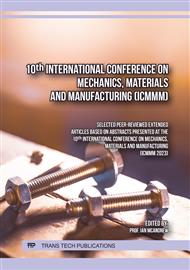p.39
p.45
p.53
p.63
p.69
p.75
p.85
p.109
p.115
Research on the Influence of Humidity on the Manufacture of GFRP Vessels in the Equatorial
Abstract:
The objective of this research work is to analyze the behavior between fiberglass laminate under tensile tests, assembled under different humidity conditions. For which specimens were designed under the regime of the international standard ASTM D3039; which took an assembly process within a controlled environment; the design variables used were relative humidity and curing time. Subsequently, the traction-displacement behavior was checked under a uniaxial force, obtaining the maximum take-off force. In addition, Simpson numerical integration was applied to calculate elastic energy. Obtaining that the relative humidity and the days of curing influence the chemical and mechanical properties of the material. Se shows that the percentage of humidity recommended for assembling laminates in GRP is 66% since it has greater elastic energy and take-off force. Finally, it is concluded that to have a high resistance in the material at least 7 days of curing of the epoxy resin must be applied.
Info:
Periodical:
Pages:
69-74
Citation:
Online since:
March 2024
Keywords:
Price:
Сopyright:
© 2024 Trans Tech Publications Ltd. All Rights Reserved
Share:
Citation:



